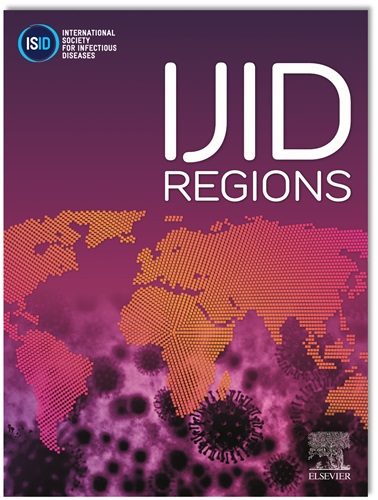2015-2023年北京市常见冠状病毒流行病学及遗传多样性的前瞻性多中心研究
IF 4.8
2区 医学
Q1 INFECTIOUS DISEASES
引用次数: 0
摘要
目的:了解新冠肺炎大流行背景下北京地区常见人类冠状病毒(hcov)的流行病学和遗传特征。方法:收集2015 - 2023年35家哨点医院急性呼吸道感染(ARTIs)患者的临床样本。通过多路实时pcr检测hcov,随后进行S基因测序和系统发育分析。结果:2015 - 2023年hcov综合检出率为1.55%(909/58,550)。在COVID-19大流行期间,观察到hcov检出率显著增加(P < 0.001)。总体而言,4种HCoV的流行季节为7 ~ 10月,每种HCoV的流行季节不同。值得注意的是,HCoV-NL63和HCoV-229E的患病率每年都有明显的变化。hcov综合检出率以≥60岁年龄组最高(1.85%),0 ~ 5岁年龄组次之(1.48%)。HCoV-229E在严重社区获得性肺炎(sCAP)患者中更为普遍(P=0.001)。系统发育分析表明,4种hcov均遭受了负选择压力,出现了多个高频氨基酸位点突变。HCoV-229E在2021年之后形成了一个新兴的谱系。结论:这项在北京进行的为期9年的多中心研究系统地阐明了四种hcov具有不同的流行病学特征、易感人群和常见的氨基酸位点突变,特别是在COVID-19背景下。因此,持续开展流行病学监测和遗传特征研究是预测预警和及时识别新型冠状病毒的必要条件。本文章由计算机程序翻译,如有差异,请以英文原文为准。
Epidemiology and genetic diversity of common human coronaviruses in Beijing, 2015-2023: A prospective multicenter study
Objectives
To investigate the epidemiological and genetic features of common human coronaviruses (HCoVs) in Beijing in the context of the COVID-19 pandemic.
Methods
We collected clinical samples from patients with acute respiratory tract infections (ARTIs) in 35 sentinel hospitals from 2015 to 2023. HCoVs were detected via multiple real-time PCR, and S gene sequencing and phylogenetic analysis were subsequently performed.
Results
From 2015 to 2023, the combined detection rate of HCoVs was 1.55% (909/58,550). During the COVID-19 pandemic, a significant increase in HCoVs detection was observed (P < 0.001). Overall, the epidemic season of four HCoVs was from July to October, and each HCoV showed different epidemic seasons. Notably, HCoV-NL63 and HCoV-229E exhibited pronounced annual alternations in prevalence. The highest combined detection rates of HCoVs were in the ≥60 years age group (1.85%), followed by the 0-5 years age group (1.48%). HCoV-229E was more prevalent in patients with severe community-acquired pneumonia (sCAP) (P = 0.001). Phylogenetic analyses revealed that the four HCoVs were subjected to negative selection pressure, and multiple high-frequency amino acid site mutations were observed. HCoV-229E formed an emerging lineage after 2021.
Conclusions
This nine-year multicenter study in Beijing systematically elucidated that the four HCoVs exhibit distinct epidemiological characteristics, susceptible populations, and common mutations in amino acid sites, especially in the context of COVID-19. Therefore, continuous epidemiological surveillance and genetic characterization studies are imperative for predictive warning and timely identification of emerging coronavirus.
求助全文
通过发布文献求助,成功后即可免费获取论文全文。
去求助
来源期刊
CiteScore
18.90
自引率
2.40%
发文量
1020
审稿时长
30 days
期刊介绍:
International Journal of Infectious Diseases (IJID)
Publisher: International Society for Infectious Diseases
Publication Frequency: Monthly
Type: Peer-reviewed, Open Access
Scope:
Publishes original clinical and laboratory-based research.
Reports clinical trials, reviews, and some case reports.
Focuses on epidemiology, clinical diagnosis, treatment, and control of infectious diseases.
Emphasizes diseases common in under-resourced countries.

 求助内容:
求助内容: 应助结果提醒方式:
应助结果提醒方式:


